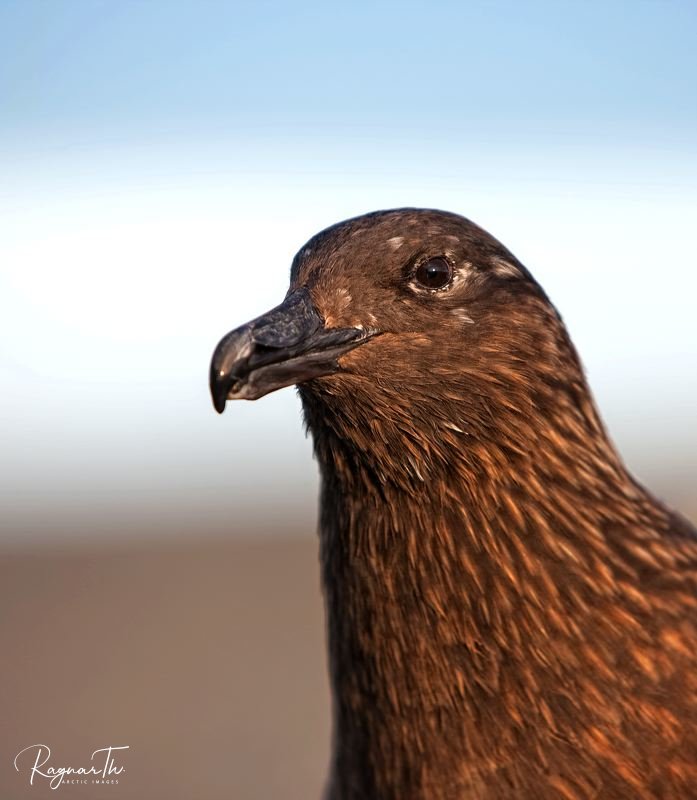The great skua (Catharacta skua, also known as Stercorarius skua) is a seabird that belongs to the Charadriiformes order within the skua family (Stercorariidae). It is an interesting bird that resembles both a large gull stocky built with webbed feet and a typical bird of prey. It has sharp claws and a hooked bill so it can kill and feed as a bird of prey.
Bird of the great black sands
The great skua is a dark bird, mostly brownish with a white stripe on the wing which is very noticeable during flight. The bill and feet are black and strong. The sexes look alike but the female is a bit larger, which is a characteristic of common with birds of prey. The great skua weighs 2.6-3.5 lbs and is 21-24 in long. The wingspan is 4.3-4.6 ft and the great skuas’ flight resembles a large gull, with its heavy wing strokes and gliding in between.
The great skua mostly lives in South Iceland and is characterizing for the black sands of the South. The biggest colonies are at Öræfi but there are also colonies at Öxarfjörður in North-East Iceland and at Úthérað in the East. The population size was estimated at 5.400 breeding pairs in 1985. There are also great skua colonies in Scotland, Norway, on the Faroe Islands, and even in Svalbard. The population has shrunk in recent years and is now in danger in Iceland.
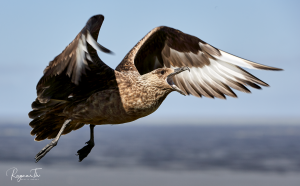
Five shady facts about the great skua
- Skúvur is a male name in the Faroe Islands.
- Icelanders have more names for the skua, such as “the ocean skua” and “the shark skua”, since it spends most of the year on the sea and can swallow very large food items (like sharks do).
- The great skua is an opportunist when it comes to feeding. It is a scavenger that eats whatever the ocean brings it, attacks birds and swallows the eggs and young of other birds.
- Juveniles roam the sea for 4-9 years before they settle down and start breeding.
- The great skua is a long-living bird that can become 40 years old, though the average lifespan is 30 years.
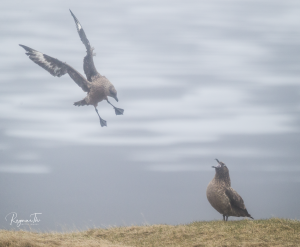
The big bad pirate
Like other seabirds, the great skua gets most of its food from the ocean. It mainly feeds on sand eel (Ammodytes marinus), chapelin (Mallotus villosus), and fish waste. The great skua is also a notorious hijacker. It harasses sterns (Sterna paradisaea), puffins (Fratercula arctica), and even gannets (Morus bassanus) to drop their catch. It hunts birds to feed on, such as fulmars (Fulmarus glacialis) and graylag geese (Anser anser), and it steals the eggs and young of other birds.
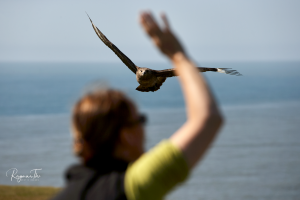
Behavior and nesting ecology
The great skuas are migratory birds that arrive in Iceland in March, occupy territory on the shores and waits for their companions. The birds pair for lifetime. The birds are social on the breeding grounds as they tend to gather around streams and ponds in the neighborhood to chat together. But still, the colonies are sparse and each pair defends its territory aggressively against intruders. The great skua is known for its fierce attacks against whoever comes near its nest. There are Icelandic legends about livestock and even humans who died of head trauma due to a great skua attack. We can question the truthfulness of these stories, but the fact remains that a skua can strike intruders with a dangerous blow.
A skua’s nest is a small dent on the ground or in a grasstop, sometimes lined with hay but often non-isolated. There are usually two eggs, light brown or olive green with dark spots. Each egg weighs about 3.18 oz. The female incubates for 29 days while the male brings food to the nest. After fledgling, the young roam the territory as the female protects them and the male brings them food.
When fall sets in, the great skua abandons its territory and heads out to sea. Juveniles roam the ocean for 4-9 years and travel widely in that time. Scientists have observed Icelandic skuas in East Atlantic, from the Bay of Biscay south to West-Africa, and even in the West-Mediterranean. They also head to East-Greenland and North to Svalbard.
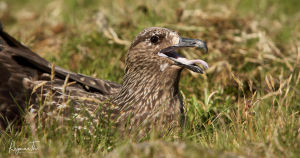
What is in a name?
The origin of the “skua” name is in the Faroese language, in words such as “skúvur” or “skúgvur”, and is the only international bird name from the Faroe Islands. Skua means the dark or the shady one. The Icelandic word “skúmaskot”, which means a dark place, is derived from the dark looking skua. Another Icelandic word that got its meaning from the skua is “kjaftaskúmur”, describing a noisy person that babbles intensively. The skua often makes laughter-like shrieks or loud babbling sounds. Most of us know one or two “kjaftaskúmur”.
Links to roam in
- A guide to the great skua from Audubon
- Key facts from The Royal Society for the Protection of Birds
- A quick look at the great skua at The Wildlife Trusts’ website
Author: Dr. Þórður Örn Kristjánsson
Photographer: Ragnar Th. Sigurðsson

